Contents
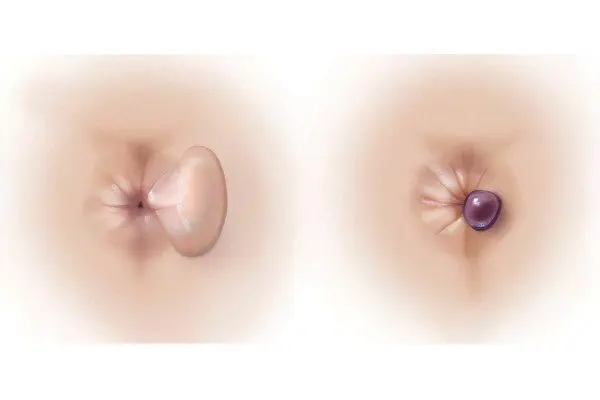
Thrombosis of the hemorrhoid is a complication of hemorrhoids, which is characterized by the appearance of a blood clot in the vessels of the rectum. It develops against the background of impaired blood circulation in the cavernous plexus of the organ. The acute stage of the disease lasts for 5 days, after which the node with a thrombus will be replaced by connective tissue. At the same time, complications in the form of necrosis, the appearance of ulcers on the intestinal mucosa and even death cannot be ruled out. The risk of developing complications of the disease is quite high, they are observed in approximately 60% of patients with hemorrhoid thrombosis.
The main symptoms of thrombosis of this localization are severe pain in the rectum, sensation of a foreign body in the anus. Perhaps, both conservative and surgical treatment of the disease.
Thrombosis of hemorrhoids in 82,3% is a consequence of chronic hemorrhoids, and in 17,7% it develops during the acute stage of the disease. Despite sufficient knowledge of the disease, it still presents a certain difficulty in treatment. The fact is that conservative therapy often allows to achieve only a temporary recovery, and surgical interventions are often complicated by relapses of the pathology. Therefore, for proctologists, thrombosis of the hemorrhoid is a very urgent problem.
Types and severity of hemorrhoid thrombosis
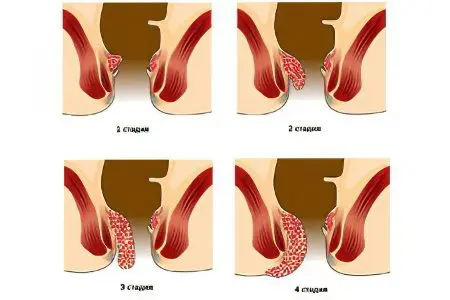
Depending on which hemorrhoidal node was affected, the following types of thrombosis are distinguished:
internal thrombosis. With internal thrombosis, blood clots can be located in several hemorrhoids at once.
external thrombosis. In this case, thrombi are most often single, that is, they are located in one of the nodes. Therefore, the clinical picture of the disease will not be so bright.
Combined thrombosis.
There are three degrees of severity of the disease:
The first degree of severity is characterized by the presence of thrombosis in the internal and external hemorrhoids, but the disease is not complicated by an inflammatory reaction. The nodules themselves, although painful, do not reach an impressive size. They are tight and elastic, can be located in the perianal region and in the anus. The areas of the dermis above the nodules are slightly reddened. The pain is moderate, present on a permanent basis. In parallel, a person may experience itching and burning in the anal canal. These sensations tend to intensify when a person has consumed spicy foods, alcoholic beverages, or spent a long time in a sitting position.
The second degree of severity. The pain becomes more intense, the hemorrhoids thicken, the redness of the skin of the perianal area increases. It is almost impossible to touch the hemorrhoids, so the doctor will be forced to refuse a digital examination. The internal sphincter is constantly in tension.
Third degree of severity. Thrombosis is characterized by inflammation not only of the hemorrhoids themselves, but also of the subcutaneous tissue. Perianal skin red, swollen. The mucous membranes of hemorrhoids undergo necrosis. Around the anus there are blue formations, which are represented by areas of pinched skin. If third-degree thrombosis is not treated, then there is a high probability of rupture of the hemorrhoid with further bleeding and the development of acute paraproctitis.
In acute hemorrhoids, blood clots are localized in the cavernous veins. Since these vessels are very small in size, as well as the thinnest branches that carry out the inflow and outflow of blood, the risk of developing a thrombus embolism is excluded. Moreover, almost all the blood from the hemorrhoid enters the portal vein.
Causes of hemorrhoid thrombosis
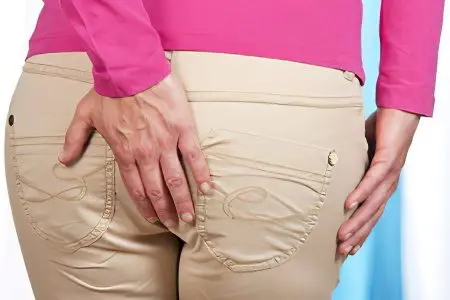
Thrombosis of the hemorrhoid is formed under the influence of many factors. First of all, we are talking about nutritional errors. In a negative way, the development of the disease is affected by the intake of alcoholic beverages, the consumption of spicy dishes, seasonings, pickles, and bitter foods. Such food helps to increase blood circulation in the pelvic organs, which naturally increases pressure in the hemorrhoids.
Constipation and frequent diarrhea also negatively affect the condition of the hemorrhoidal plexuses. Such violations of the processes of digestion of food are observed not only against the background of intestinal disorders, but also due to the predominance of dishes on the menu that do not contain enough fiber.
Another reason that can lead to the development of the disease is a sedentary lifestyle. The more a person sits, the longer the blood stagnates in the pelvic organs.
The birth of a child can also be associated with the formation of thrombosis in the hemorrhoids. In general, any sharp increase in intra-abdominal pressure negatively affects the course of the disease. Therefore, a blood clot can form even with strong physical stress.
Any injury to hemorrhoids is associated with a high probability of the formation of a blood clot in it. Hypothermia is a risk factor.
Spasm of the anal sphincter against the background of pain can also provoke the development of thrombosis.
Thus, the pathogenesis of thrombosis of the hemorrhoid is reduced to trauma to the walls of the hemorrhoid itself, as well as to congestion in the cavernous bodies of the intestine. To the place where there is tissue injury, leukocytes and platelets begin to constrict, which produce fibrin fibers. It is they who later form a blood clot that fills the node. Gradually, the thrombus grows, the node ceases to receive the nutrition it needs, which leads to the death of its tissues.
Symptoms of hemorrhoid thrombosis
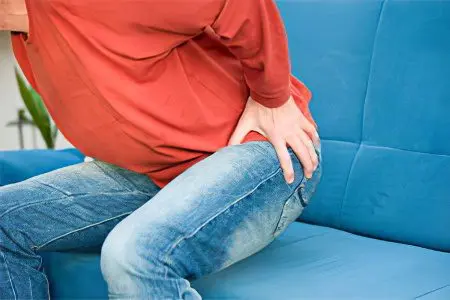
Asymptomatic disease is very rare.
Its main features are:
Painful sensations that increase during walking, with bowel movements, with prolonged sitting.
The patient will feel that there is a foreign body in his anus.
In the anus, itching and burning are constantly present.
The skin around the anus is swollen.
Muco-fibrous contents may be discharged from the rectum.
Since thrombosis of the hemorrhoid is always associated with an inflammatory reaction, during an exacerbation of the disease in a person, the local and general body temperature rises, weakness and nausea occur.
The severity of symptoms depends on the stage of the pathological process.
Diagnosis of thrombosis of the hemorrhoidal node
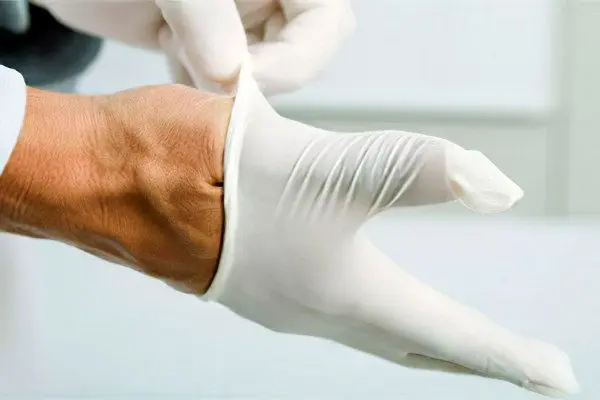
To make a correct diagnosis to a doctor, a standard examination of the patient and a survey of his main complaints are enough. During the appointment, the doctor visualizes and palpates moderately or severely painful hemorrhoids (the degree of pain depends on the stage of development of the pathology).
Hemorrhoids with a thrombus are located below the scallop line, if we are talking about the external form of the disease. With internal thrombosis, a groove will be located between the prolapsed node and the skin of the perianal region. If the node is inside the rectum, then during a rectal examination, the doctor palpates painful formations that have a round shape.
The patient must be prescribed a blood coagulogram. According to its results, violations of hemostasis will be detected. In patients with acute thrombosis, hypercoagulability, inhibition of fibrinolytic activity, and retraction of the blood clot can be traced. The thrombosed index is increased. The level of fibrinogen is increased.
The picture of the general blood test gives an increase in the number of leukocytes.
To clarify the diagnosis and turn away other pathologies, the patient is prescribed rectoscopy, or examination of the rectum using a rectal mirror. This allows you to exclude a tumor of the rectum, anal fissures, paraproctitis in the acute stage, polyps of the rectum.
Treatment of hemorrhoidal thrombosis

Treatment of patients with thrombosis of the hemorrhoid can be both conservative and surgical. Most proctologists are of the opinion that one should try to get rid of the disease with the help of medications. The operation can be performed exclusively in specialized proctology departments. Be sure to send for emergency surgery patients who have severe bleeding from internal hemorrhoids.
Treatment with conservative methods begins with the elimination of pain experienced by the patient. It is also important to direct efforts to prevent the development of complications, to eliminate the inflammatory process and stop thrombosis. Therefore, in addition to systemic treatment, the patient should receive local therapy.
To accelerate the lymphatic outflow, improve blood microcirculation, reduce capillary permeability, it is necessary to take phlebotropic drugs. It can be Rutin, Escin, Tribenozide.
To reduce pain, patients are prescribed Detralex. Also, this drug acts as an anti-inflammatory agent. Detralex can be prescribed for the treatment of pregnant women. Paracetamol and derivatives based on it have a good analgesic effect. You can also use NSAIDs for pain relief, for example, Ketorolac.
When choosing drugs for local treatment, one should take into account which symptom comes to the fore – thrombosis, pain, inflammation, tissue necrosis. For pain relief, ointments with dicaine and bupivacaine can be used. It is possible to use combined gels with glucocorticosteroids and astringent components, for example, Proctosedil, Aurobin, Heparin ointment, etc.
Ointments Levasin and Levomekol are prescribed in the case when thrombosis of hemorrhoids is complicated by inflammation of the subcutaneous tissue and the perianal region.
To stop bleeding, local hemostasis is most often sufficient, for which drugs such as Androxon, Spongostan, Tachocomb are used.
Suppositories are widely used to treat hemorrhoids. Combinations of active ingredients in them may be different. Such drugs as are popular: Relief, Posterisan, Proctosedil, Nigepan.
In the complex treatment of hemorrhoids complicated by thrombosis, low-intensity laser radiation is used. 5-7 sessions are shown, each of which lasts from 5 to 7 minutes. Already after the second procedure, the inflammation will decrease, the swelling from the perianal area will subside, the nodes will become softer and painless.
The pain syndrome can be successfully stopped with the help of novocaine-alcohol blockades. They allow you to remove swelling from the tissues and significantly improve the patient’s condition.
Most often, thrombosis of hemorrhoids can be eliminated with the help of conservative methods of treatment. However, it should not end after the symptoms of the disease subside. The main task of the doctor and the patient is to prevent the recurrence of inflammation, which is possible due to competent prevention.
Prevention of thrombosis of hemorrhoids

First of all, a person must adjust his diet. You should refuse to take laxatives, but at the same time increase the amount of vegetable fiber consumed, as well as fluids. The diet should be enriched with bran, seaweed, flaxseed. You can take the drug Macrogol 4000.
If a person suffers from diarrhea, then he is shown taking Loperamide, but with sufficient volumes of liquid.
You should completely abandon the use of coffee, tea, alcoholic beverages, spicy foods, seasonings and spices.
Any injury to the anus is associated with a risk of recurrence of the disease, so it is necessary to strive for soft and regular bowel movements. In addition to proper nutrition, sufficient physical activity can help in this.









